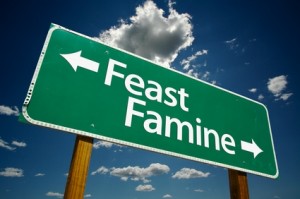周末苦短啊,我开着三个电脑监视屏,耳朵听着“我是歌者”林志玄的天籁之声,眼睛一边浏览着“非诚勿扰”的字幕和画面,一边阅读搜索引擎到的信息,而手在忙着敲字写博客。久病成医,但是更多是迷惘困惑,希望能有高人给我指点迷津。 这里分享我觉得很重要的一篇文章,“关于无谷蛋白饮食的误区”。文中最后提到的误区是直接转换成GLUTEN FREE 饮食!听来令人寒毛倒立,如果没有考虑到先治愈可能的肠炎性症(IBD),直接吃GLUTEN FREE GRAIN 会引起新的过敏由于肠粘膜屏蔽通透性病变(LEAKY GUT)! 炎症性肠病它有两个概念。一个是广义的,一个是狭义的。 各种炎性肠病都可以叫广义炎性肠病。但是狭义的就是指两个病,一个是溃疡性结肠炎(UC);一个是克隆氏症。关于炎症性肠病的诊断和治疗可参考连接 http://baike.baidu.com/view/2329166.htm http://www.xinyao.com.cn/yyxhk/yanzhengxingchangbing/ 原文的要点摘译如下: 很多人因为健康原因不能或者不应该吃谷蛋白。他们饱尝像湿疹,头痛 或关节痛,却不知道真正的病因是不耐受谷蛋白或者CELIAC DESEASE。不知您是否其中之一。有300种症状和不耐受谷蛋白有关。很多人已经意识到这个病因开始无谷蛋白饮食,不幸的是在这个过程里,很多人步入误区,减慢或停滞了他们治愈的过程。 误区之一,相信”GLUTEN FREE“ 标签 FDA 的GLUTEN FREE标准是食物含有20PPM GLUTEN。但是更糟糕的是很多无谷蛋白食物大经RANCID OIL, 糖 或者稠化剂处理过,并很快转化为糖。 玉米油,canola油, safflower油, 葵花油和豆油都富含不饱和脂肪酸,容易引起肠炎症,从而不利于过敏体质的人。 稠化剂,比如guar gum, sorghum, 米淀粉 and arrowroot 对于过敏体质的人不容易消化。 误区之二,相信成份没列GLUTEN 就是GLUTEN FREE 误区之三,饱食终日还缺营养 误区之四,浅尝辄止,半途而废 误区之五,仅仅GLUTEN FREE还 是不够。 人困马乏了,容老娜改日详细给您译来。晚安!
Mistake #1: Believing Labels  “’Certified gluten-free’ doesn’t necessarily mean the food is gluten-free. The same way ‘fat-free’ doesn’t actually mean fat free most of the time. Clever lawyers, massive legal loopholes, and mega food manufacturers tied in with government is what makes this possible. And it is the reason Celiacs [or gluten sensitive folks] often say ‘but I am eating gluten free, why don’t I feel well, why am I not getting better?” says Jaqui Karr (emphasis mine). “’Certified gluten-free’ doesn’t necessarily mean the food is gluten-free. The same way ‘fat-free’ doesn’t actually mean fat free most of the time. Clever lawyers, massive legal loopholes, and mega food manufacturers tied in with government is what makes this possible. And it is the reason Celiacs [or gluten sensitive folks] often say ‘but I am eating gluten free, why don’t I feel well, why am I not getting better?” says Jaqui Karr (emphasis mine).
Current FDA standards allow “gluten free” products to contain 20 parts per million (PPM) gluten, and that’s not even the worst of it. Unfortunately, most gluten-free foods are highly processed with rancid oils, sugar and thickening agents that quickly convert to sugar in the body. Now you may be asking, “Why would anyone intentionally use rancid oils?” In most cases I’m sure they don’t, but oils such as corn, canola, safflower, sunflower, and soy are rich in polyunsaturated fatty acids (PUFA’s) which become very unstable during the extraction process. PUFA’s inhibit the healing process of those trying to recover from food sensitivities/allergies by triggering gut inflammation in a situation where the gut lining is already compromised. On the other hand thickening agents such as guar gum, sorghum, rice starch and arrowroot bring a completely different set of complications. As I’ll discuss later on, people with food sensitivities very often have lost the ability to digest food properly. Starches like the above thickening agents are virtually indigestible in these cases, so they rot in the gut and feed pathogenic bacteria that further damage digestive function (not to mention devastate the metabolism and cause weight gain!). Mistake #2: Assuming Products That Don’t List Gluten As An Ingredient Are Safe  Gluten in your ketchup, shampoo and even your absolutely 100% gluten-free toast? Oh yes! Here are some other surprising ways you can get “glutened.” Gluten in your ketchup, shampoo and even your absolutely 100% gluten-free toast? Oh yes! Here are some other surprising ways you can get “glutened.”
- Foods that don’t list gluten anywhere on the label. “As food becomes more refined, gluten is used as a stabilizing agent in products such as ketchup and ice cream. But don’t always expect to see it on a food’s ingredient list: If it’s used in the manufacturing process, it’s often not mentioned on the label of the product,” says this article. Here’s a very helpful list of foods that either definitely contain gluten or are likely to.
- Personal care and beauty products. Shampoos, soaps, deodorants, lipsticks, lotions, all-natural hair sprays and even things like hand sanitizer often contain gluten in the form of wheat germ oil, hydrolized wheat protein, oats, hydrolized oat protein, textured plant protein, etc.
- Vitamins and supplements. A random sampling recently found that nearly 25% contain or are contaminated with gluten.
- Bulk bins. Those addictive dried mangos or raw walnuts may be sitting in a bin that previously held cereal, oats or cornmeal.
- Well meaning family, friends, and even restaurants! “Often good intending people say things are GF when they are not gluten-safe. For example: a local restaurant said they had GF bread. I was thrilled! But then I saw them put the bread in a toaster, where other non-gf bread was being toasted,” says Gluten Free Chickie.
For those that are not dealing with a true allergy you may do fine with a little gluten here and there, but it might be worth weeding a few things out to avoid overexposure. Mistake #3: Becoming Well-Fed But Malnourished  Gluten-free diet recommendations often focus on replacing gluten-laden junk food with safer alternatives – an approach that ignores the critical nutrient deficiencies celiacs and gluten sensitive folks often face. Gluten-free diet recommendations often focus on replacing gluten-laden junk food with safer alternatives – an approach that ignores the critical nutrient deficiencies celiacs and gluten sensitive folks often face.
But what about those that aren’t eating junk food? Is it possible, as my friend Sandrine often says, to be both well-fed and malnourished? Yep, and here’s why: A healthy intestine has an abundance of villi (tiny, finger-like projections that increase the intestinal surface area), which allows for the absorption of nutrients into the bloodstream. With celiac disease [or gluten sensitivity] these villi are flattened and proper absorption of nutrients is compromised. The continued malabsorption of nutrients such as calcium, magnesium, vitamin D, B vitamins, and omega-3 fatty acids can contribute to mood disorders, lower energy levels, poor bone health, insomnia, attention problems, and a host of other issues.’ (source)
Does going gluten-free correct this? Unfortunately, the answer is often no. A recent study found that 10 years after going gluten-free over 50% of celiac patients were still suffering from poor vitamin status. This may be because patients were eating gluten-free junk food OR they could be eating well but not absorbing nutrients properly. To gain access to the nutrients in food celiacs and gluten sensitive folks must carefully rebuild their microvili and overall gut lining. More on how to do that later on! Mistake #4: Giving Up After A Few Days Because You Feel Worse  “Twenty-four hours after I stopped eating gluten, I felt like I got kicked by a horse,” Holly says in this article, adding that she “simply could not function and just basically stared at the walls. A few days later I started feeling better. That was what convinced me that, for me, gluten was a drug. It was a real drug to the point I went into withdrawal if I couldn’t get it.” “Twenty-four hours after I stopped eating gluten, I felt like I got kicked by a horse,” Holly says in this article, adding that she “simply could not function and just basically stared at the walls. A few days later I started feeling better. That was what convinced me that, for me, gluten was a drug. It was a real drug to the point I went into withdrawal if I couldn’t get it.”
She’s right. As I wrote about in Healing Your Inner Junkie, improperly digested grains can act like morphine in the body and produce very real withdrawal symptoms. Mistake #5: Stopping with Gluten Ahhh, here we are: The part where you resist the urge to call me names while l you that going gluten-free is usually not enough. Once the gut lining has been compromised, exposure to grains of any kind will create more inflammation and damage. For that reason, many experts including Dr. Natasha Campbell-McBride recommend a temporary removal of all grains from the diet alongside the addition of healing foods such as chicken broth, healthy fats and fermented foods. We did this last year, and the results have been amazing. My husband lost 50+ pounds and has continued to see an overall improvement in health and focus and we were able to re-introduce grains without problems this summer.
|
